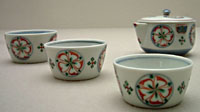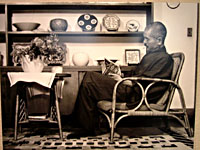|
TOMIMOTO KENKICHI
Dreams for a Perfectly Set Table Come True
By ROBERT YELLIN
for the Japan Times, Dec. 22, 2004
|
|
Tomimoto Kenkichi Exhibit
Runs through Feb. 27 (2005), and features 110 pieces by this artist.

Sake cups in ume design,
blue underglaze, 1934

Traveling tea set
with five petal flower design,
overglaze enamel, 1950

Tomimoto at home
in Soshigaya, Tokyo, 1932

Click here for
Photo Tour of
Work by
Tomimoto Kenkichi
PHOTOS BY
ROBERT YELLIN
AND DOMON KEN
Daily Vessels by Kenkichi Tomimoto: The Master of Ceramic Art is at the National Museum of Modern Art, Crafts Gallery, in Tokyo until February 27, 2005. The museum is a short walk from Takebayashi Station on the Tozai subway line, exit 1B.
Closed Dec. 29 thru Jan. 1,
and open January 2 and 3. Admission 200 yen for adults.
Click here to visit
museum's web site
|
|
|
|
|
"Everybody sets out to do something, and everybody does something, but no one does what he sets out to do," said Irish author George Moore of the good intentions that abound in life.
Setting an idea in motion is often more important than the end result, whether one creates products, ideas, or life itself. Tomimoto Kenkichi (1886-1963) is one example of Japan's finest and most influential ceramic artists, ever. Although Tomimoto is well known for his huge ornamental works, in his own words he wished "to produce large quantities of inexpensive vessels that have been designed by a true artist and manufactured in a coordinated, well-organized pottery, in order that every kind of person, in every kind of house can use it; inexpensive pottery that anybody can buy and that nobody can afford to be without."
Compared to other countries, Japan does have a sense of tableware over and above the commonplace, but yet nothing like Tomimoto envisioned.
His dreams for setting our tables are now on display at an exhibition of over 110 of his works titled Daily Vessels by Kenkichi Tomimoto at The National Museum of Modern Art, Crafts Gallery, in Tokyo, but he was never able to mass produce his tableware in the affordable way that he had aimed for, partly because his designs kept on being copied and produced more cheaply.
In a survey of museum curators, critics, and gallery owners conducted by the Honoho Geijutsu (The Art of Fire, 2001) magazine as to which ceramic artists were the most important of the 20th century, Tomimoto was ranked first in Japan, way ahead of his more famous contemporaries such as Hamada Shoji. What was so important about Tomimoto?
Besides being considered the greatest decorator and innovator of modern porcelain, he has written prolifically on art, most notably about William Morris and wielded considerable influence as a university professor; he founded the ceramics department at the Kyoto Municipal College of Fine Arts and many of his students went on to become well-known contemporary ceramic artists.
Tomimoto was born into a wealthy landowning family from Nara and had an elite upbringing, spending two years in England (1908-1910) where he studied interior decoration, furniture, textiles and he learnt his skills as a painter. He also studied stained glass.
Upon his return, he built his first kiln at his home in 1915 producing low-fired raku wares. His closest friend at the time was the British potter Bernard Leach; the two were lifelong chums and both made a solemn vow concerning their pots: No matter how attractive old patterns may be, they would never ever copy an existing pattern and would only create their own. Hence Tomimoto's motto: "Don't make patterns from patterns."
This incomparable potter always strove to keep his designs fresh and chose to base his work on things found in the natural world. On Tomimoto's works the most common plants take on a special life of their own -- his favored motifs are quadrefoils, ferns, grape leaves, thistles and willows.
Many of his plates and boxes also feature idyllic pastoral scenes such as winding country lanes or his famous bamboo thickets under the moon.
Tomimoto insisted on throwing pots himself, seeing the entire process through from inception to production and thus deviating from the established practice of his youth in which each process of pottery production was divided up between different craftsmen. Tomimoto would have none of the old, except to learn from it and make it his own.
Tomimoto's career can be divided into three distinct stages each based in a different location:
- the Yamato Period (Nara, 1915 -)
- the Tokyo Period (1926 -)
- the Kyoto Period (1946 - 1963)
Works from all periods are represented in the current exhibition, but many of the pieces on display were created or designed during his many trips to regional potteries, such as at Hasami (Nagasaki), Mashiko (Tochigi), Seto (Aichi) and Kutani (Ishikawa).
The works created on these travels form a distinct part of Tomimoto's oeuvre. "At least once a year I would visit one of the main pottery districts around the country and fire some pots," he wrote. "I would not throw the pots myself but choose my favorite shapes from among the local bodies, using the clay, firing techniques and glazes unique to the area, the only freedom of expression I would allow myself being in the decoration."
Tomimoto was also an early supporter and influential member of the folk-art Mingei movement, with its potting centers around the country. Yet the notion of being "an unknown potter" greatly conflicted with Tomimoto's self-centered stance, and he later distanced himself from their activities.
Still, much of his work certainly has a warm Mingei feel. Tomimoto felt, as William Morris once said, that: "if you want a golden rule that will fit everything, this is it -- have nothing in your houses that you do not know to be useful or believe to be beautiful." This was to remain an unrealized dream of Tomimoto's, as he so dearly wanted our tables to be places of beauty and inspiration.
Daily Vessels by Kenkichi Tomimoto: The Master of Ceramic Art is at the National Museum of Modern Art, Crafts Gallery, in Tokyo until February 27. The museum is a short walk from Takebayashi Station on the Tozai subway line, exit 1B. Closed December 29 through January 1, and open January 2 and 3. Admission 200 yen for adults.
The Japan Times: December 22, 2004
(C) All rights reserved
 |
PHOTO TOUR OF WORK BY TOMIMOTO KENKICHI
LEARN MORE
|